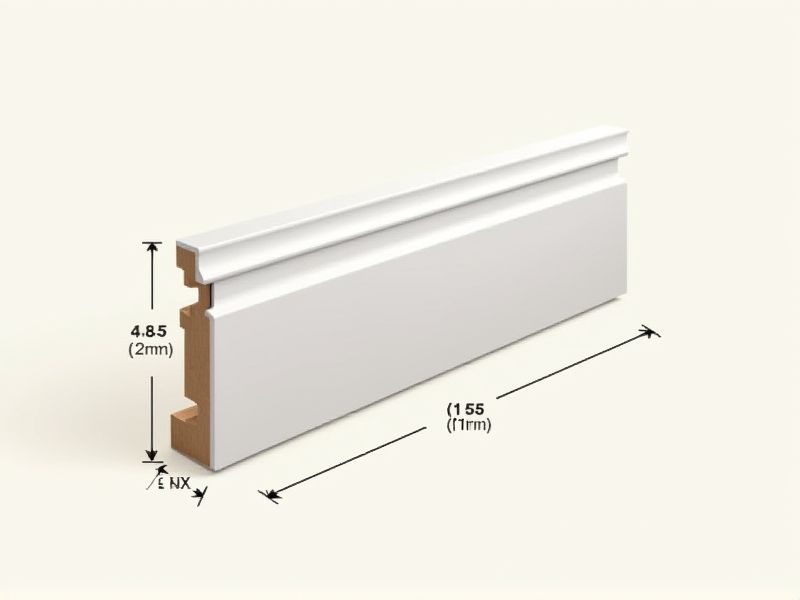
When selecting baseboard for your home, it's helpful to know that the standard height typically ranges from 3 to 5 inches, with some styles going as high as 7 inches for a more dramatic look. The thickness is usually about 1/2 to 3/4 inch, providing enough durability while still fitting snugly against the wall. Choosing the right size depends on your ceiling height and room proportions--for example, taller baseboards often complement rooms with higher ceilings. Keeping these standard dimensions in mind can make it easier to shop for baseboards and achieve a cohesive, professional-looking finish in your space.
Height Variations
Baseboard height typically ranges from 3 to 5 inches, depending on the architectural style and design preferences of your space. Taller baseboards, around 6 to 8 inches, create a more dramatic effect and can complement high ceilings effectively. When selecting baseboards, consider the overall proportion of your room; for instance, shorter baseboards may suit ceilings below 8 feet, while taller ones enhance the elegance of larger spaces. Custom options are available, allowing you to tailor the height and style to fit your unique aesthetic and functional needs.
Thickness Options
Baseboard thickness options typically range from 1/2 inch to 1 inch, providing various levels of durability and aesthetic appeal. Thicker baseboards, often measuring around 3/4 inch to 1 inch, are ideal for high-traffic areas, offering enhanced resistance to wear and impact. In contrast, thinner baseboards, usually at 1/2 inch, can create a more minimalist look, perfect for modern interior designs. When selecting the appropriate thickness for your project, consider the overall style of your home and the functional demands of each room.
Material Types
Baseboards are typically constructed from a variety of material types, including wood, MDF (medium-density fiberboard), and PVC (polyvinyl chloride). Wood baseboards, such as oak or pine, offer a natural aesthetic and durability, while MDF provides cost-effective and paintable options ideal for modern settings. PVC baseboards are moisture-resistant, making them suitable for areas prone to humidity, such as bathrooms or kitchens. When selecting the right baseboard, consider factors like your budget, desired style, and the environmental conditions of your space.
Profile Styles
Baseboard profiles play a crucial role in interior design, influencing both aesthetics and functionality. Various styles, such as colonial, modern, and Victorian, cater to diverse architectural themes, offering options ranging from simple, straight lines to intricate, detailed designs. The height of baseboards typically ranges from 3 to 6 inches, and materials commonly used include wood, MDF, and PVC, each providing unique durability and finish possibilities. When selecting a baseboard profile, consider how it complements your room's overall style and enhances the visual appeal of your spaces.
Length Availability
Baseboards typically range in length from 8 to 16 feet, catering to various interior designs and project requirements. The standard thickness of baseboards usually varies between 1/2 inch to 1 inch, allowing for a seamless fit against walls and floors. Common materials include MDF, wood, and PVC, each offering unique aesthetics and durability. When selecting baseboards, consider the profile height, which can range from 3 to 8 inches, significantly impacting the overall visual appeal of your space.
Pre-Finished Colors
Pre-finished baseboards are available in a variety of colors, with options ranging from classic white to bold navy and rich mahogany, enhancing the overall aesthetic of your space. These baseboards typically feature durable finishes, ensuring resistance to scratches and fading, maintaining their vibrant appearance for years. The thickness of pre-finished baseboards usually ranges from 5/8 inch to 1 inch, providing a sturdy border that complements various flooring types. When selecting your baseboard, consider how the color and finish will harmonize with both your wall shades and flooring design to create a cohesive look.
Installation Methods
Baseboard installation methods vary, with conventional techniques encompassing nail and adhesive applications. You can choose from two primary installations: the traditional nail-on approach, which utilizes finishing nails for secure attachment, or a modern adhesive method that simplifies the process. It's crucial to ensure proper measurements, typically between 3 to 6 inches in height, to suit your room's aesthetic. Properly prepped walls and the use of a level can enhance installation precision, ensuring a flawless finish that complements your space.
Moisture Resistance
Moisture-resistant baseboards are essential for homes in humid environments, as they help prevent warping and decay. Made from materials like PVC or treated wood, they can withstand high moisture levels, reducing the risk of mold growth. In these installations, the average cost per linear foot can range from $3 to $7, depending on the material chosen. For optimal performance, ensure that your baseboard installation includes proper sealing and ventilation techniques to maximize durability.
Flexibility In Design
Baseboards offer significant design flexibility, accommodating various interior styles ranging from contemporary to traditional with heights typically varying from 3 to 5 inches. Customizable materials, including wood, MDF, and PVC, allow you to tailor the finish to match your decor aesthetic. With options for painted, stained, or natural finishes, you can achieve a seamless blend with your walls or create a bold contrast. The versatility in baseboard profiles--from simple straight lines to intricate carvings--ensures that your space reflects personal taste while fulfilling practical needs like hiding electrical wires or preventing wall damage.
Cost Considerations
When selecting baseboard materials, the cost significantly influences your options; hardwoods typically range between $3 to $10 per linear foot, while MDF offers a more affordable alternative at $1 to $3 per linear foot. Installation costs can also vary, with labor fees averaging around $2 to $5 per linear foot, depending on regional rates. Consider maintenance expenses, as painted MDF may require repainting more frequently than natural wood options, which can affect long-term budgeting. Overall, making informed decisions based on both initial and ongoing costs will help you achieve a balance between aesthetics and affordability.
